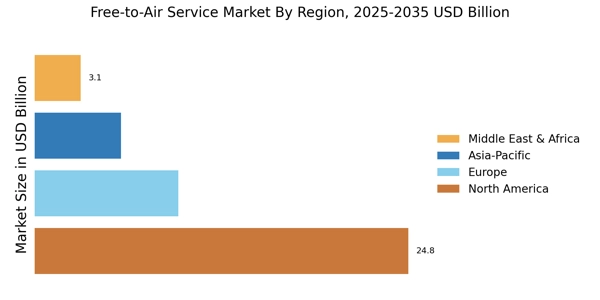Rising Demand for Diverse Content
The Free-to-Air Service Market experiences a notable increase in demand for diverse content offerings. Audiences are increasingly seeking varied programming, including local news, sports, and entertainment. This trend is driven by the desire for accessible content that reflects cultural and regional preferences. As a result, service providers are expanding their content libraries to cater to these preferences. According to recent data, the number of channels available in the Free-to-Air Service Market has grown by approximately 15% over the past three years, indicating a robust response to consumer demand. This diversification not only enhances viewer engagement but also attracts advertisers looking to reach specific demographics, thereby bolstering revenue streams for service providers.
Increased Penetration of Smart Devices
The proliferation of smart devices is significantly impacting the Free-to-Air Service Market. As more consumers adopt smart TVs, smartphones, and tablets, the accessibility of free-to-air content has expanded. This trend is particularly evident in regions where internet connectivity is improving, allowing users to stream free-to-air content seamlessly. Data indicates that the number of smart device users has surged by over 25% in the last two years, facilitating greater engagement with free-to-air services. This increased penetration not only enhances viewer convenience but also opens new avenues for advertisers to reach audiences through targeted campaigns. The integration of free-to-air services with smart technology is likely to redefine viewing habits and further stimulate growth within the Free-to-Air Service Market.
Regulatory Support and Policy Frameworks
The Free-to-Air Service Market benefits from supportive regulatory frameworks that promote accessibility and competition. Governments in various regions are implementing policies aimed at ensuring that free-to-air services remain available to all citizens. These regulations often include mandates for local content and public service broadcasting, which enhance the diversity of programming available. As a result, the Free-to-Air Service Market is likely to see continued growth, as regulatory support fosters an environment conducive to innovation and investment. Recent policy changes have led to an increase in funding for public broadcasters, further solidifying the role of free-to-air services in the media landscape. This regulatory backing is crucial for maintaining the viability and relevance of free-to-air offerings.
Technological Integration and Innovation
Technological integration plays a pivotal role in shaping the Free-to-Air Service Market. The advent of digital broadcasting and advancements in transmission technologies have significantly improved the quality and accessibility of free-to-air services. Innovations such as high-definition broadcasting and mobile viewing options have expanded the reach of these services. As of October 2025, it is estimated that over 70% of households have access to digital free-to-air services, reflecting a shift towards modern viewing preferences. This technological evolution not only enhances user experience but also positions free-to-air services as competitive alternatives to subscription models. The ongoing innovation within the Free-to-Air Service Market suggests a promising future as providers continue to adapt to changing consumer expectations.
Cost-Effectiveness of Free-to-Air Services
The Free-to-Air Service Market is characterized by its cost-effectiveness, which appeals to a broad audience base. Unlike subscription-based services, free-to-air options do not require monthly fees, making them accessible to individuals and families with varying income levels. This affordability is particularly significant in regions where disposable income is limited. Recent statistics suggest that approximately 60% of households prefer free-to-air services due to their financial advantages. This trend is likely to continue, as economic factors influence consumer choices. The cost-effectiveness of free-to-air services not only enhances viewer accessibility but also encourages advertisers to invest in these platforms, further driving growth within the Free-to-Air Service Market.


















Leave a Comment